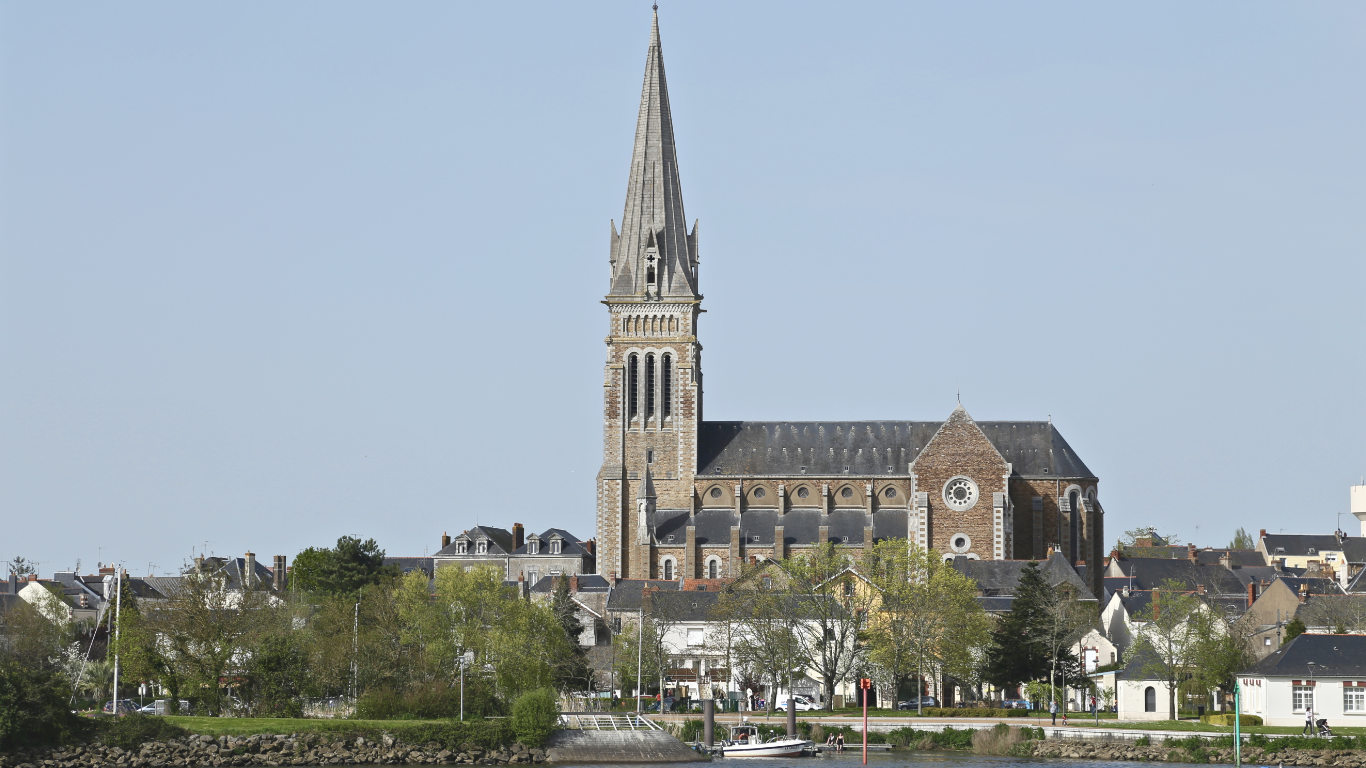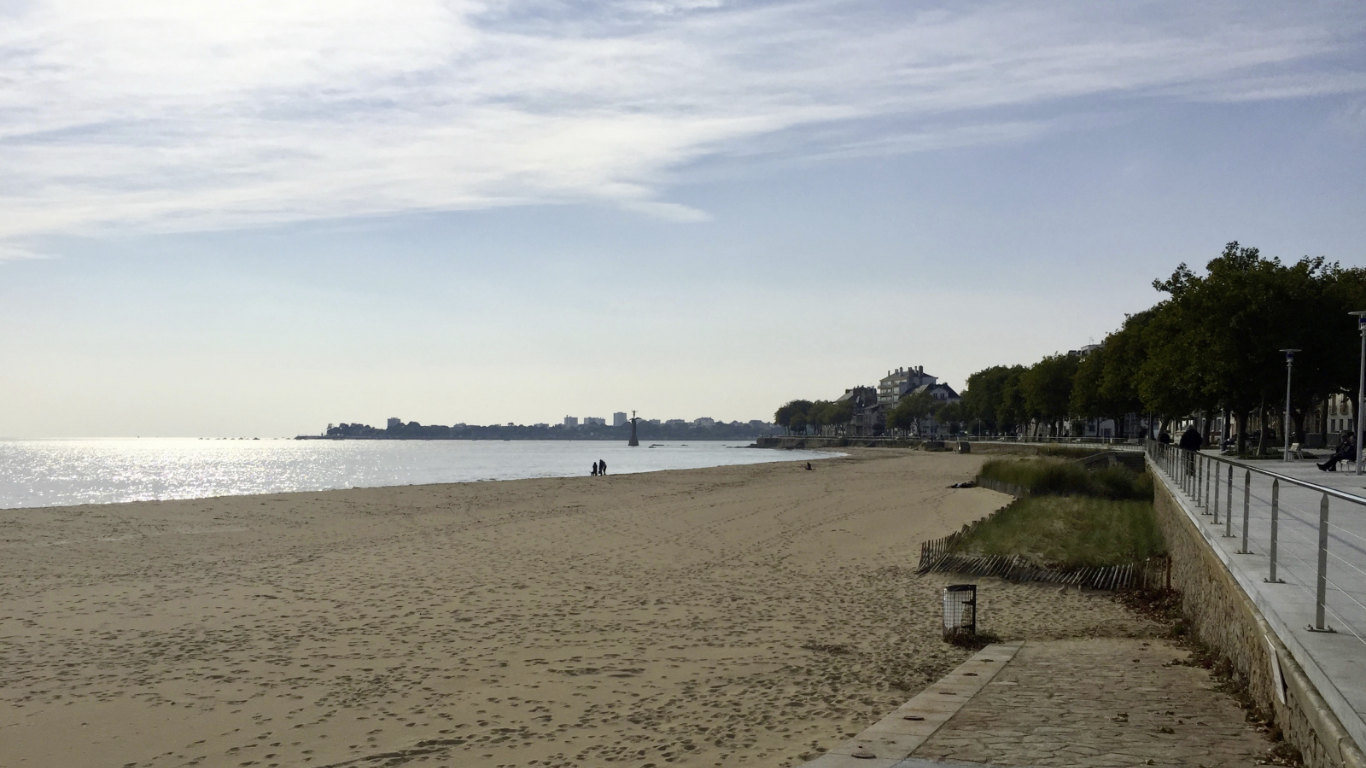
Saint Nazaire – beaches, wartime history, submarine base, cruiser liners … and Tintin!
For many people the name Saint-Nazaire is indelibly linked with ships and the Nazi Occupation of France during the Second World War. After all, this large port in the Loire-Atlantique at the mouth of the River Loire was once the stopping off point for ocean liners from Panama, Mexico, and Cuba, and is still to this day a major shipbuilding city: Cunard Line’s flagship RMS Queen Mary 2 was built there. And Saint-Nazaire was a key strategic port for the Germans during the war, where they built a virtually indestructible submarine or U-boat base.
The town, which promotes itself with the slogan ‘A city by the sea’, has 20 beaches along the coast to the west, towards Pornichet. One of these, the Saint-Marc-sur-Mer beach, was made famous in the 1953 comedy Mr. Hulot’s Holiday (‘Les Vacances de M. Hulot‘) by French film director Jacques Tati (see Hulot statue right). Tati had visited the beach with friends before the Second World War and was determined to make a film there one day. Shooting took place in 1951. Another fictional link is with the comic strip character Tintin. Part of Hergé’s story The Seven Crystal Balls was set tin Saint-Nazaire, with Tintin himself, captain Haddock and Snowy the dog all visiting the port. In 1986 a society of local Tintin fans put up six posters of scenes from the book at various places in the city that the characters in the book visited.
Things to do and see in Saint-Nazaire
Go to a museum in a submarine base: Escal’Atlantic, the Ocean Liner Experience
The ‘Ville-Port’ is where a fascinating ‘museum’ experience called Escal’Atlantic has been built inside the old submarine base itself. Here you can witness the world of transatlantic liners from the heyday of cruise travel. Learn more.
View the scenery on a two-hour Cruise “Saint-Nazaire by the Sea”
Other developments around the old base have now turned what was once a deserted and soulless location into a lively and interesting place to visit. You can also take a cruise from the harbour; tickets can be bought from the old submarine base. The trip takes two hours and costs €20 for an adult, €10 for children (4 to 14).
See the restored Tumulus of Dissignac (4,000 BC) and other sights
Saint-Nazaire, which was only developed as a major town in the middle of the 19th century and which was heavily bombed in the Second World War and had to be almost entirely re-developed, is sometimes described as the city that was built twice in less than a century. For that reason there are not too many historic buildings on view. But it does boast a couple of prehistoric monuments, the Tumulus of Dissignac (4,000 BC) and a megalithic stone formation of ‘dolmen’ near the city centre. There is also the Villès-Martin fort on the estuary itself, built in 1861 (sadly not usually open to visitors) and the Kerlédé lighthouse, which went out of service in 1961. There is also, of course, the massive but elegant Saint-Nazaire bridge, opened in 1975, which spans the mighty Loire Estuary over a distance of 3.3 kilometres.
Last but not least there is what is known locally as ‘Sammy’ or even ‘Saint-Nazaire’s Statue of Liberty’. This is a monument that was erected in 1927 on the tenth anniversary of the arrival of American troops in Saint-Nazaire during the First World War. In December 1941 Nazi invaders ripped down the ten-ton American Monument (as it is officially called), apparently to make use of the bronze. After a public appeal for donations an identical replica of the original work was installed in its place.
Experience the stunning marshland by bike or flat boat!
Saint-Nazaire was built on the edge of marshland. Just a short distance from the city – 8 or 9 km away – is the Parc naturel régional de Brière. Sometimes also known La Grande Brière, this natural park covers 54,800 hectares (about 135,000 acres), of which 18,000 hectares (about 44,000 acres) is marshland. It’s a stunning, flat and sometimes desolate landscape, criss-crossed with many small canals and punctuated by little villages and thatched cottages. It’s a great place to hire a bike or, better still, a traditional flat boat and explore at your leisure. Traditionally it was an important source of peat and today the boggy area is a great habitat for many different types of birds including the short-eared owl, the northern pintail duck and the black-tailed godwit. It is also home to stoats, weasels and brown hares.
To hire bikes and find out more about the area ahead for the pretty little hamlet of Kerhinet where the tourist office or ‘Maison du Parc’ is based.
Getting to Saint-Nazaire
By air
Nantes Atlantique Airport is just under an hour’s drive away from Saint-Nazaire. It has regular UK flights to London City airport with CityJet, while Flybe has a service to Southampton and Manchester. There are also regular flights to and from Dublin and many other European destinations.
Paris is about 440 km (about four-and-a-half hours). Nantes is 64 km away (just under an hour) and Calais is 650 km (about six hours).
By train
The high-speed train TGV links Saint-Nazaire to Paris several times a day; allow for approximately two-and-a-half hours on direct trains. Via Nantes, there are connections with many other French cities (for example Lille, Strasbourg, Marseille and Bordeaux).
By ferry
Saint-Nazaire is about 200km from Saint-Malo (about two hours 20 minutes).
Photo 1 by smilla4 /CC BY 2.0 image cropped; all other images by juseliushausammann.com



